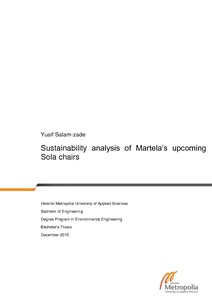Sustainability analysis of Martela’s upcoming Sola chairs
Salam-zade, Yusif (2015)
Salam-zade, Yusif
Metropolia Ammattikorkeakoulu
2015
All rights reserved
Julkaisun pysyvä osoite on
https://urn.fi/URN:NBN:fi:amk-2015120719662
https://urn.fi/URN:NBN:fi:amk-2015120719662
Tiivistelmä
In this thesis, three approaches to quantify products’ sustainability are used and compared. The sustainability evaluation methods are limited to the ones that were available to the author at the time. Products compared are six variations of chairs from Martela’s Sola product family. Software used is The Footprinter for the carbon footprint study, Nativalab’s Ouro for the sustainability life cycle assessment, and GreenDelta’s openLCA for the life cycle impact assessment. Commercial licenses for The Footrpinter and Ouro were provided by The Natural Interest, and openLCA is an open-source application. ELCD database was used as the main source of life cycle inventory data, and impact methods used were CML baseline and ILCD 2011.
The carbon footprint study of the products revealed that the chair model with the least amount of steel had the lowest emission equivalent while the model with the most amount of steel had the highest. The SLCA study highlighted the weak areas sustainability-wise in the production chain, and the LCIA study concluded that the ELCD database is not sufficient for a thorough LCA study.
The carbon footprint study of the products revealed that the chair model with the least amount of steel had the lowest emission equivalent while the model with the most amount of steel had the highest. The SLCA study highlighted the weak areas sustainability-wise in the production chain, and the LCIA study concluded that the ELCD database is not sufficient for a thorough LCA study.
